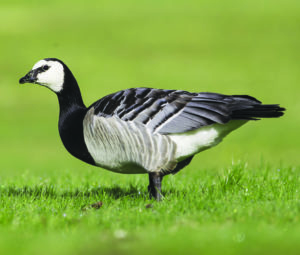Every year, millions of birds criss-cross the planet, soaring above our heads in search of food, warmth and mates. From pole to pole, here are some of the most remarkable journeys made by our feathered friends.
So-called “summer migrants”, like the common cuckoo, are bird species which spend roughly

October to March in warmer climes than that of the UK, such as those of Portugal, Senegal and the Congo Basin.
In the UK’s summer months, there is such an abundance of airborne insects – their diet of choice – that these birds are not only able to feed themselves but can successfully raise a family too.
But in the autumn, when it’s too cold for many insects to fly, the birds return south where the weather is warmer and there are flies available all year round.
Believe it or not, some birds come to Europe in winter for its milder weather. Species such as barnacle geese breed in the Arctic, where there are full days of sunlight and plenty of grass on which to feed during the spring and summer. When the cold weather sets in, they migrate south to take advantage of the warmer winters.
Long distance
The Arctic tern, which holds the record for the longest migration of any bird, breeds in the very north of Europe and Asia during summer before migrating all the way to the Antarctic Ocean to spend another summer: this time in the southern hemisphere.
This journey across the entire globe covers a distance of about 35,000km. The oldest known Arctic tern survived for 31 years, which means it travelled over 1.6m kilometres in its lifetime – more than the equivalent of travelling to the moon and back twice.
Lots of species follow a section of the Arctic terns’ route by going from north to south and back: but the red-necked phalarope offers a twist on this classic journey. This bird, which weighs 27-48g – the same as between one and two small bags of crisps – flies west from Scotland to Peru and back each year.
A study has shown that one red-necked phalarope, which bred on the Shetland Isles, flew west to cross the Atlantic Ocean before stopping over at the border between the US and Canada.
The bird then flew down the east coast of the US and crossed over onto the Pacific coast of Mexico. From there, it continued south until it reached the coast of Peru, where it spent

October to April. This marathon flight is typical behaviour for individuals breeding in Scotland, Iceland or Greenland.
Top speed
Although the peregrine falcon is known to be able to reach the fastest speed of any animal, reaching up to 322kmph during one of its steep dives or “stoops”, its average speed in level flight is between 65-95kmph: enough to comfortably keep up with a standard car. Now, imagine a bird able to keep that speed up for 6,760km.
That’s the feat achieved by tens of thousands of great snipes each year. This brown wading bird looks unassuming as it feeds at the edges of lakes and in soft mud, but when it’s time to migrate it can fly non-stop for almost seven thousand kilometres at an average speed of 97kmph. This extraordinary journey takes individuals from Sweden, where they breed, to sub-Saharan Africa, where they spend winter.
High fliers
One of the more fascinating aspects of bird migration is the extreme heights at which birds often choose to travel. Cooler air is thinner, requiring less effort to fly through. The coolness also prevents birds from overheating whilst using their wing muscles so much. But the downside to this is the much lower oxygen levels in upper regions of the Earth’s atmosphere, resulting in increased risk of hypoxia: where the levels of oxygen reaching the body’s tissues are insufficient, potentially causing damage.
Birds counteract this by producing more red blood cells, which help carry more oxygen through their body. This is the same process that occurs in human athletes training at high altitudes.
Astonishingly, there have been reports of bar-headed geese flying above the highest Himalayan peaks – which can reach over 8km. This species’ unique physiology, including larger lungs and brains able to tolerate low carbon dioxide levels in the blood, has long fascinated researchers.
Smaller birds, such as pied flycatchers, also use cooler air to travel, often flying at night so that they don’t have to fly as high to reach sufficiently cool areas. Because of this, they’re called nocturnal migrants. These birds navigate using the stars, only landing to refuel during the day. We know that they travel by night by recording their in-flight calls as they pass overhead during the hours of darkness.
(The Conversation)



